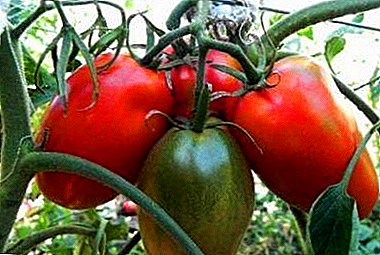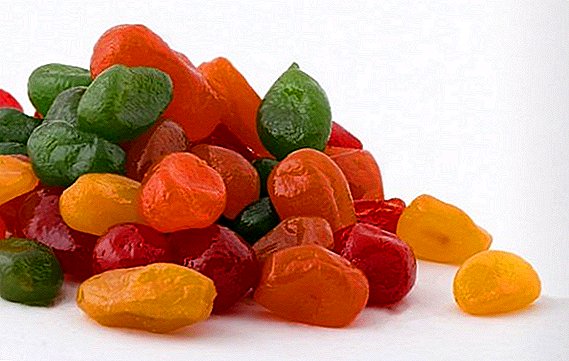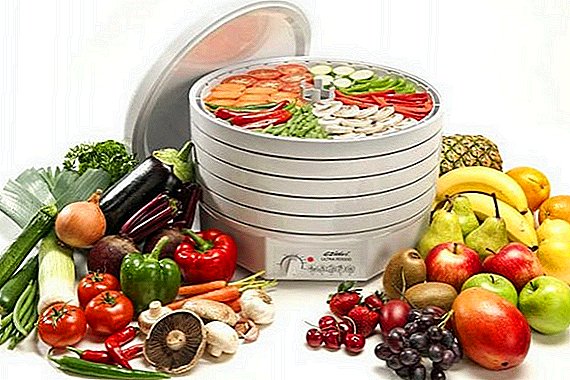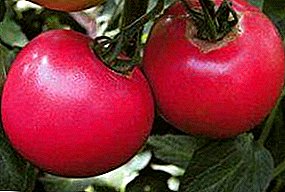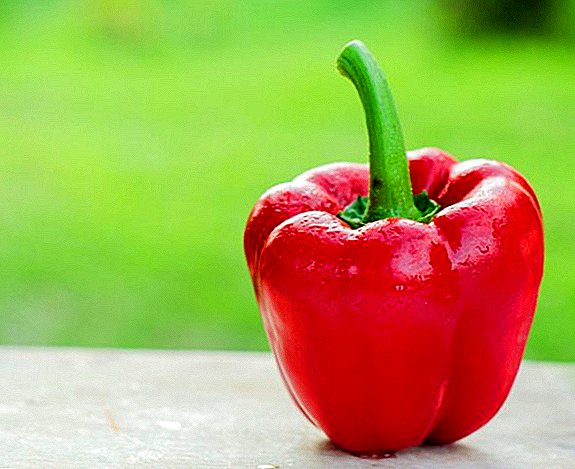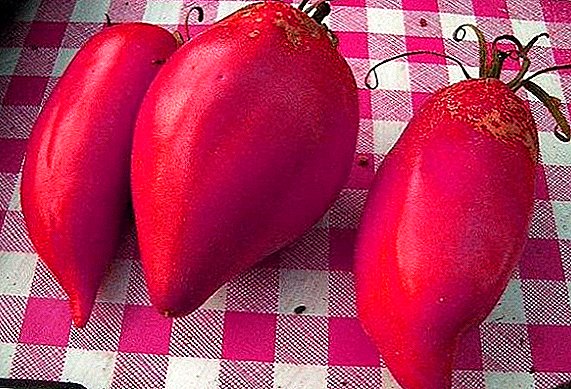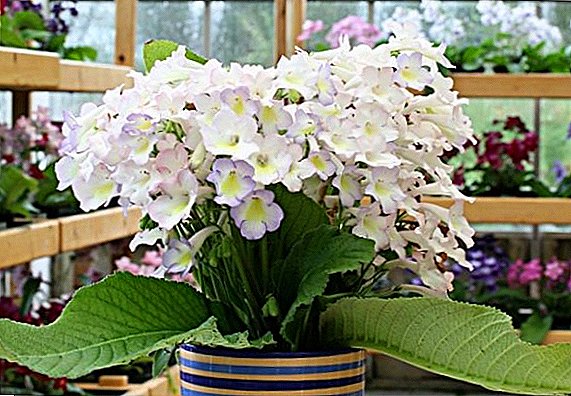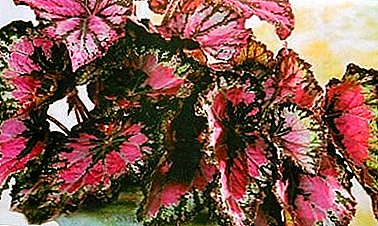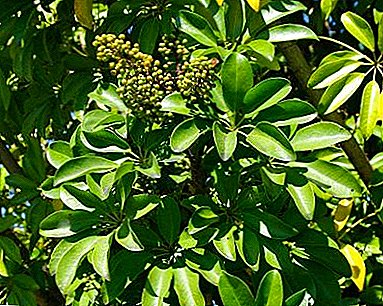
Schefflera is the largest member of the Aralia family from Southeast Asia. The Sheffler family, named after the German botanist Jacob Scheffler, includes about 150 species of trees, shrubs and vines.
Some Scheffler species are grown as an ornamental plant.
Florists are attracted to the lacy foliage, resembling open palms or a holey umbrella, as it is sometimes called.
This fast-growing plant does not require complex care and is great for gardening rooms, offices and open courtyards.
General description of the plant
Schefflera arboricola Schefflera Arboricola is a miniature version of Schefflera Radiophony.. In nature, this evergreen plant reaches 8-9 meters in height (radiant grows to 15 meters). The young shoots are green, as they become woody turn brown. Complex leaves consist of 7-9 parts, each of which can reach 20 cm in length and 4 cm in width.
In home plants grows up to 2 meters. Breeders deduced many varieties of this plant, differing in shape and color of leaves. Among the popular ones are the Gold Chapel (with golden spots on the leaves), Hong Kong, Kompakta and others.
A photo
The photo shows a plant with proper care at home:




Home care
Actions after purchase
Young Shefflers usually sell seated in thin plastic containers with peat or other light substrate. You can give the plant a few days to get used to new conditions, and then you need to transplant into a larger pot with a thick layer of drainage and suitable soil.
Temperature
 Scheffler prefers coolness, the best temperature range for it is 16-22 ° C.
Scheffler prefers coolness, the best temperature range for it is 16-22 ° C.
In the summer, she feels good outdoors, can be carried out on the balcony, covering from the direct rays of the sun.
Too high temperature harms the plant, causes leaves to fall, so even in the cold season you should not put a pot with a “Shefflera” near the battery or heater.
For wintering it is better to choose a cool room of 14-16 ° С, but not to allow the temperature to fall below 12 ° С.
Lighting
Best of all, they grow under diffused but bright light. Direct sunlight can cause burns on the leaves, so it is best to place the plant on the east or west side.
Adjustable shutters can be installed on the window to keep leaves and soil from drying out. If wintering takes place in a warm room, where the temperature is above 17-18C, additional lighting will be needed, it is preferable to install fluorescent lamps.
Watering
Schefflera requires uniform irrigation to maintain soil moisture during the growing season. In winter, watering should be reduced. The soil between watering can dry out, but it should not be allowed to dry the roots or, on the contrary, stagnant moisture - this can lead to rotting of the roots or infection of the plant.
Blackening leaves are a sure sign of excessive watering. The lack of moisture can be determined by shriveled or folded leaves.
Fertilizer
During the period of active growth (from April to October), it is possible to feed a complex fertilizer for houseplants once every 10-15 days. If desired, you can alternate between mineral and organic fertilizers.
Transplant and soil
 It is best to replant Scheffler in spring, young plants require transplantation every 2 years., and more adults - every 4-5 years.
It is best to replant Scheffler in spring, young plants require transplantation every 2 years., and more adults - every 4-5 years.
Light soil with a weak acid reaction will be required.
Ready soil for palm trees or a mixture of turf and leaf earth, sand and humus (2: 1: 1: 1) will do.
Special attention should be paid to the drainage layer - it should occupy at least a quarter of the height of the pot. Expanded clay is suitable as a drainage.
After transplantation, you need to give the plant time to get used to the new land. About a month later, you can resume feeding.
Pruning
Rapid growth can be a nuisance when it is kept in small spaces. If the plant has become too high, you need to pruning, removing the upper part of the shoot with a point of growth.
This will give an impetus to the Schefflera branch and does not allow it to grow too much. The resulting cutting can be rooted. The optimal time for pruning is at the beginning of March.
Interesting! Regularly cutting the tops, you can get a round crown.
If you want to give the plant the shape of a tree you need to remove the lower side leaves.
Breeding
"Schefflera", growing at home, usually does not bloom and does not give seedstherefore, it is propagated by semi-distorted cuttings or by air branches.
Cut the cuttings with a sharp knife in a soil substrate of equal parts of sand and peat. To ensure a suitable temperature (about 22 ° C), diffused light and humidity, cover them with a film or place them in a greenhouse. After rooting, the temperature must be reduced to 18 ° C.
Young plants can be transplanted when their roots envelop the whole earthen room. The diameter of the pot should be no more than 9 cm. Low, not higher than 16 ° C, the temperature contributes to better growth.
Air layouts can be obtained from a large adult tree by cutting into the trunk. On the incision you need to put the sphagnum soaked in a nutrient medium, and wrap it with a film. By maintaining the moisture of the moss, in a few months you can get the roots on the trunk of a tree.
After that, you need to cut the trunk just below the cut. The remaining part, too, is likely to give new shoots, if you cut it at the root and water regularly. In this way, you can get two plants from one.
Diseases and pests
 Schefflera Trees are less susceptible to pest attacks than other species of this plant.
Schefflera Trees are less susceptible to pest attacks than other species of this plant.
Most often, Scheffler is attacked by a spider mite.
This happens when the air humidity is low, so for prevention it is enough to spray the leaves of the plant with a mild soap solution once a week.
Other insect pests that are not indifferent to Schefflera are aphids, scale insects, thrips.
All of them are sensitive to modern insecticides.
Excessively moist soil can cause root rot.
To combat the disease, it is necessary to reduce the intensity of irrigation and treat the land with a solution of a fungicide.
Important! Shefflera leaves are a kind of plant status monitor.
So, the bright spots on them indicate too bright light. If the leaves fall in winter, you need to raise the temperature in the room and reduce watering. When falling off in the summer, on the contrary, move to a cooler place.
Benefit and harm
"Schefflera Treelike" refers to slightly poisonous plants. However, she is unlikely to harm an adult. As a safety measure, you can wash your hands after trimming the plant and avoid getting its juice in your eyes.
Attention! Care must be taken to the "Scheffler" owners of small animals and cats.
At the first signs of poisoning (vomiting, diarrhea, anxiety) it is necessary to show the pet to the veterinarian.
In the well-lit, spacious room of the Schefflera, the Tree quickly grows into a beautiful tall plant. It is worth giving it a little attention to protect it from drought and pests, and the open palm of the leaves will delight the eye with its bright glossy greenery all year round.


